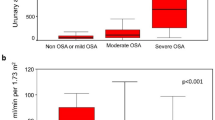Abstract
Background and aim
Obstructive sleep apnea syndrome (OSAS) is an independent risk factor for the development of cardiovascular events and hypertension. The possible causes are oxygen desaturation due to hypopnea, increased cytokine levels and insulin resistance. All these risk factors also have a role in the progression of chronic kidney disease (CKD). The aim of this study was to determine the relationship between OSAS and the severity of CKD.
Materials and methods
We retrospectively evaluated the medical records of 175 subjects who were admitted for the polysomnography study. OSAS was diagnosed by polysomnography if Apnea-Hypopnea Index (AHI) > 5 and glomerular filtration rate (GFR) was calculated with Cockcroft–Gault formula. According to AHI, individuals with AHI < 5 were recruited as group 1 (OSAS negative group), those with AHI = 5–15 group 2 (mild OSAS group), those with AHI = 15–30 group 3 (moderate OSAS group), and those with AHI > 30 group 4 (severe OSAS group).
Results
Of the subjects, 117 (67%) were men, 58 (33%) were women and the mean age was 54.0 ± 12.1 years. There were 28 (14.3%), 18 (10.3%), 35 (20.0%) and 97 (55.4%) patients in groups 1, 2, 3 and 4 respectively. The prevalence of diabetes mellitus and hypertension and body mass index was significantly higher in severe OSAS group (P < 0.05). A significant decrease in GFR was detected when the severity of OSAS increased (group 1 = 50.0 ± 11.8, group 2 = 44.8 ± 15.9, group 3 = 40.8 ± 14.7, group 4 = 38.8 ± 16.0; P for trend < 0.001).
Conclusion
In the light of the present study, we speculate that OSAS is an independent risk factor for the progression of chronic kidney disease, which is a growing health problem. Further randomized-multicenter prospective studies are warranted to evaluate this relationship.

Similar content being viewed by others
References:
Weiss JW, Launois SH, Anand A, Garpestad E (1999) Cardiovascular morbidity in obstructive sleep apnea. Prog Cardiovasc Dis 41:367–376
Yang WS, Lee WJ, Funahashi T et al (2001) Weight reduction increases plasma levels of an adipose-derived anti-inflammatory protein, adiponectin. J Clin Endocrinol Metab 86:3815–3819
Hallett M, Burden S, Stewart D, Mahony J, Farrell P (1995) Sleep apnea in end-stage renal disease patients on hemodialysis and continuous ambulatory peritoneal dialysis. ASAIO J 41:M435–M441
Kimmel PL, Miller G, Mendelson WB (1989) Sleep apnea syndrome in chronic renal disease. Am J Med 86:308–314
Kraus MA, Hamburger RJ (1997) Sleep apnea in renal failure. Adv Perit Dial 13:88–92
Kuhlmann U, Becker HF, Birkhahn M et al (2000) Sleep-apnea in patients with end-stage renal disease and objective results. Clin Nephrol 53:460–466
Yamauchi M, Nakano H, Maekawa J et al (2005) Oxidative stress in obstructive sleep apnea. Chest 127:1674–1679
Mancia G, De Backer G, Dominiczak A et al (2007) 2007 Guidelines for the Management of Arterial Hypertension: The Task Force for the Management of Arterial Hypertension of the European Society of Hypertension (ESH) and of the European Society of Cardiology (ESC). J Hypertens 25:1105–1187
Rechtschaffen A (1968) A manual of standardized terminology, techniques, and scoring system for sleep stages in human subjects. VCLA, Los Angeles
EEG arousals (1992) Scoring rules and examples: a preliminary report from the Sleep Disorders Atlas Task Force of the American Sleep Disorders Association. Sleep 15:173–184
Johns MW (1991) A new method for measuring daytime sleepiness: the Epworth sleepiness scale. Sleep 14:540–545
Coresh J, Selvin E, Stevens LA et al (2007) Prevalence of chronic kidney disease in the United States. JAMA 298:2038–2047
Dizdar O, Alyamac E (2004) Obesity: an endocrine tumor? Med Hypotheses 63:790–792
de Oliveira Rodrigues CJ, Marson O, Tufic S et al (2005) Relationship among end-stage renal disease, hypertension, and sleep apnea in nondiabetic dialysis patients. Am J Hypertens 18:152–157
Millman RP, Kimmel PL, Shore ET, Wasserstein AG (1985) Sleep apnea in hemodialysis patients: the lack of testosterone effect on its pathogenesis. Nephron. 40:407–410
Fein AM, Niederman MS, Imbriano L, Rosen H (1987) Reversal of sleep apnea in uremia by dialysis. Arch Intern Med 147:1355–1356
Beecroft J, Duffin J, Pierratos A, Chan CT, McFarlane P, Hanly PJ (2006) Enhanced chemo-responsiveness in patients with sleep apnoea and end-stage renal disease. Eur Respir J 28:151–158
Auckley DH, Schmidt-Nowara W, Brown LK (1999) Reversal of sleep apnea hypopnea syndrome in end-stage renal disease after kidney transplantation. Am J Kidney Dis 34:739–744
Hanly PJ, Pierratos A (2001) Improvement of sleep apnea in patients with chronic renal failure who undergo nocturnal hemodialysis. N Engl J Med 344:102–107
Dursunoglu N, Dursunoglu D (2005) Obstructive sleep apnea syndrome, endothelial dysfunction and coronary atherosclerosis. Tuberk Toraks. 53:299–306
Schulz R, Hummel C, Heinemann S, Seeger W, Grimminger F (2002) Serum levels of vascular endothelial growth factor are elevated in patients with obstructive sleep apnea and severe nighttime hypoxia. Am J Respir Crit Care Med 165:67–70
Sim JJ, Rasgon SA, Kujubu DA et al (2009) Sleep apnea in early and advanced chronic kidney disease: Kaiser Permanente Southern California cohort. Chest 135:710–716
Author information
Authors and Affiliations
Corresponding author
Rights and permissions
About this article
Cite this article
Kanbay, A., Buyukoglan, H., Ozdogan, N. et al. Obstructive sleep apnea syndrome is related to the progression of chronic kidney disease. Int Urol Nephrol 44, 535–539 (2012). https://doi.org/10.1007/s11255-011-9927-8
Received:
Accepted:
Published:
Issue Date:
DOI: https://doi.org/10.1007/s11255-011-9927-8




